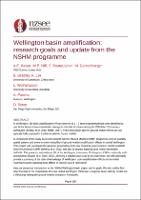Wellington basin amplification: research goals and update from the National Seismic Hazard Model Programme

Download
Date
2021-04-14Authors
Kaiser, Anna
Hill, Matt
Wotherspoon, Liam
Bradley, Brendon
Lee, Robin
Roten, Daniel
Bourguignon, Sandra
Pancha, Aasha
Gerstenberger, Matt
Metadata
Show full item recordAbstract
In Wellington, 3D basin amplification effects observed at 1 – 2 second spectral periods were identified as one factor likely to have exacerbated damage to mid-rise structures during the 2016 Mw 7.8 Kaikōura earthquake (Bradley et al. 2018; MBIE, 2017). These local basin-specific ground-motion effects are not typically fully captured in traditional seismic hazard models.
A component of the newly launched National Seismic Hazard Model (NSHM) programme aims to quantify spatial patterns and event-to-event variability of ground-motion amplification effects in central Wellington. This project will investigate the advances provided by both new empirical ground motion models available since the previous NSHM (Stirling et al. 2012) and also by physics-based ground motion simulation methods. The geometry and sediment fill of the Wellington basin under Wellington’s CBD is relatively well-characterised (Kaiser et al. 2019; 2020), allowing a detailed case study to be undertaken. We will ultimately provide a summary of the state-of-knowledge of Wellington basin amplification effects and an initial roadmap towards capturing these effects in seismic hazard nationwide.
Here we present an introduction to the NSHM Wellington basin project and its goals. We also outline first steps focused on the compilation of a new central Wellington Vs30 map, a regional basin velocity model and a Hikurangi earthquake ground-motion simulation framework.
